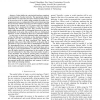Free Online Productivity Tools
i2Speak
i2Symbol
i2OCR
iTex2Img
iWeb2Print
iWeb2Shot
i2Type
iPdf2Split
iPdf2Merge
i2Bopomofo
i2Arabic
i2Style
i2Image
i2PDF
iLatex2Rtf
Sci2ools
INFOCOM
2005
IEEE
2005
IEEE
Buffer sizing for congested Internet links
— Packet buffers in router/switch interfaces constitute a central element of packet networks. The appropriate sizing of these buffers is an important and open research problem. Much of the previous work on buffer sizing modeled the traffic as an exogenous process, i.e., independent of the network state, ignoring the fact that the offered load from TCP flows depends on delays and losses in the network. In TCP-aware work, the objective has often been to maximize the utilization of the link, without considering the resulting loss rate. Also, previous TCP-aware buffer sizing schemes did not distinguish between flows that are bottlenecked at the given link and flows that are bottlenecked elsewhere, or that are limited by their size or advertised window. In this work, we derive the minimum buffer requirement for a Drop-Tail link, given constraints on the minimum utilization, maximum loss rate, and maximum queueing delay, when it is feasible to achieve all three constraints. Our results...
Related Content
| Added | 25 Jun 2010 |
| Updated | 25 Jun 2010 |
| Type | Conference |
| Year | 2005 |
| Where | INFOCOM |
| Authors | Amogh Dhamdhere, Hao Jiang, Constantinos Dovrolis |
Comments (0)

